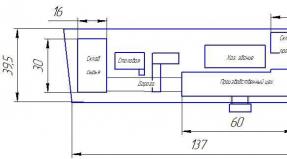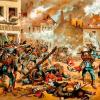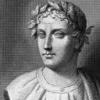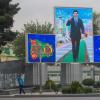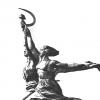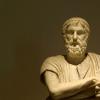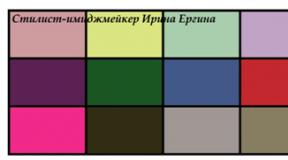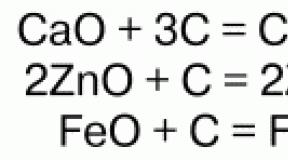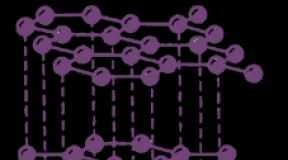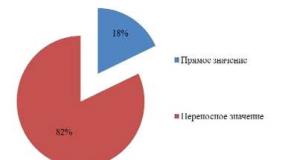Icon of Gregory Palamas. Icon of Gregory Palamas: painted with light. Troparion of Saint Gregory
Saint Gregory Palamas, Archbishop of Thessalonica, was born in 1296 in Asia Minor. During the Turkish invasion, the family fled to Constantinople and found shelter at the court of Andronicus II Palaiologos (1282-1328). Saint Gregory's father became a major dignitary under the emperor, but soon died, and Andronicus himself took part in the upbringing and education of the orphaned boy. Possessing excellent abilities and great diligence, Gregory easily mastered all the subjects that made up the full course of medieval higher education. The emperor wanted the young man to devote himself to state activity, but Gregory, having barely reached the age of 20, retired to Mount Athos in 1316 (according to other sources, in 1318) and entered the Vatopedi monastery as a novice, where, under the guidance of the elder, the Monk Nikodim of Vatopedi ( Comm. 11 July), took tonsure and began the path of asceticism. A year later he appeared in a vision Holy Evangelist John the Theologian and promised his spiritual protection.
Gregory's mother, along with his sisters, also became monks. After the repose of Elder Nikodim, Monk Gregory went through his feat of prayer for 8 years under the guidance of Elder Nicephorus, and after the death of the latter, he moved to the Lavra of St. Athanasius. Here he served at the meal, and then became a church singer. But three years later (1321), striving for higher levels of spiritual perfection, he settled in a small hermitage Glossia. The abbot of this monastery began to teach the young man concentrated spiritual prayer - smart doing, which was gradually developed and assimilated by the monks, starting with the great hermits of the 4th century, Evagrius of Pontus and Saint Macarius of Egypt(commemorated January 19). After in the XI century in the writings Simeon the New Theologian(Comm. 12 March) detailed coverage was given to external prayer methods of mental work, it was assimilated by the Athos ascetics. The experimental application of smart doing, requiring solitude and silence, was called hesychasm (from Greek - peace, silence), and the practitioners themselves began to be called hesychasts. During his stay in Glossia, the future saint was completely imbued with the spirit of hesychasm and accepted it for himself as the basis of life. In 1326, due to the threat of an attack by the Turks, together with the brethren, he moved to Thessalonica (Thessalonica), where he was then ordained a priest.
Saint Gregory combined his duties as a presbyter with the life of a hermit: he spent five days of the week in silence and prayer, and only on Saturday and Sunday did the shepherd go out to the people - perform divine services and deliver sermons. His teachings often evoked tenderness and tears in those present in the temple. However, complete detachment from public life was not characteristic of the saint. Sometimes he attended theological meetings of urban educated youth, led by the future Patriarch Isidore. Returning somehow from Constantinople, he discovered a place near Thessalonica Berea, convenient for a solitary life. Soon he gathered here a small community of hermit monks and led it for 5 years. In 1331 the saint withdrew to Athos and retired to the skete of Saint Sava, near the Lavra of Saint Athanasius. In 1333 he was appointed Abbot of the Esfigmen Monastery in the northern part of the Holy Mountain. In 1336 the saint returned to the skete of Saint Sava, where he engaged in theological works, which he did not leave until the end of his life. Meanwhile, in the 30s of the fourteenth century, events were brewing in the life of the Eastern Church that placed Saint Gregory among the most significant ecumenical apologists for Orthodoxy and brought him fame as a teacher of hesychasm. Around 1330, the learned monk Varlaam arrived in Constantinople from Calabria. The author of treatises on logic and astronomy, a skillful and witty orator, he received a chair at the metropolitan university and began to interpret the works Dionysius the Areopagite(Comm. 3 October), whose apophatic theology was equally recognized by the Eastern and Western Churches. Soon Varlaam went to Athos, got acquainted there with the way of spiritual life of the Hesychasts and, on the basis of the dogma of the incomprehensibility of the being of God, declared smart doing a heretical delusion. Traveling from Athos to Thessalonica, from there to Constantinople and then back to Thessalonica, Varlaam entered into disputes with the monks and tried to prove the creation of the Light of Tabor; At the same time, he did not hesitate to ridicule the monks' stories about prayer methods and spiritual insights.
Saint Gregory, at the request of the Athonite monks, first addressed with verbal exhortations. But, seeing the failure of such attempts, he set out his theological arguments in writing. Thus appeared the "Triads in Defense of the Holy Hesychasts" (1338). By 1340, the Athos ascetics, with the participation of the saint, compiled a common response to the attacks of Varlaam - the so-called "Svyatogorsk Tomos". At the Council of Constantinople in 1341 in the church of Hagia Sophia, a dispute took place between St. Gregory Palamas and Barlaam, which focused on the nature of the Light of Tabor. On May 27, 1341, the Council adopted the provisions of St. Gregory Palamas that God, inaccessible in His Essence, reveals Himself in energies that are turned to the world and are accessible to perception, like the Light of Tabor, but are not sensual and not created. The teachings of Barlaam were condemned as heresy, and he himself, anathematized, withdrew to Calabria.
But the disputes between the Palamites and the Barlaamites were far from over. Among the latter were Varlaam's disciple, the Bulgarian monk Akindin and Patriarch John XIV Kaleka (1341-1347); Andronicus III Palaiologos (13281341) also leaned towards them. Akindin came out with a number of treatises, in which he declared St. Gregory and the monks of Athos to be the perpetrators of church troubles. The saint wrote a detailed refutation of Akindin's conjectures. Then the Patriarch excommunicated the saint from the Church (1344) and subjected him to imprisonment, which lasted three years. In 1347, when Isidore (1347-1349) replaced John XIV on the patriarchal throne, Saint Gregory Palamas was released and elevated to the rank of Archbishop of Thessalonica. In 1351 Blachernae Cathedral solemnly testified to the Orthodoxy of his teachings. But the Thessalonians did not immediately accept Saint Gregory, he was forced to live in different places. On one of his trips to Constantinople, a Byzantine galley fell into the hands of the Turks. For a year Saint Gregory was sold in various cities as a prisoner, but even then he tirelessly continued the preaching of the Christian faith. Only three years before his death he returned to Thessalonica. On the eve of his death, he appeared in a vision Saint John Chrysostom. With the words "To the mountain! To the mountain!" Saint Gregory Palamas peacefully reposed in God on November 14, 1359. In 1368 he was canonized at the Council of Constantinople under Patriarch Philotheos (1354-1355, 1362-1376), who wrote the life and service of the saint.
Based on materials Patriarchy.ru
Ὁ ξεχασμένος Ἅγιος;
Reflections on the reasons for the lack of proper liturgical veneration of St. Gregory Palamas in the Russian Church
“Whoever purifies his body by abstinence, and by love makes anger and lust an occasion for virtues, by prayer he purifies his mind to stand before God, he will acquire and see in himself the grace promised by a pure heart ...”
November 14 (according to the Julian old calendar), in theory, the entire Orthodox Church celebrates the memory of the repose of St. Gregory Palamas, Archbishop of Thessaloniki. According to Bishop Veniamin (Milov), “The theologians-liturgists, through their liturgical creations, deliver every Christian into a living feeling of the co-presence of the supreme Triune Spirit in all His terrible majesty and, at the same time, inexplicable love for the human race.” (1) That is, the liturgical following of the holy Church are not just a certain scheme and rule of prayer, but also a way and method of raising a person into the presence of the Triune God, raising the mind to the footstool of the throne of the Lamb. The liturgical life of the Church, her liturgical charter, like the breath of the Church, is also a reflection of the inner life of the Church, her breath, an expression of her consciousness, of the intense historical path she has traveled for the preservation of "the faith once delivered to the saints." (Jude.) The Church of Christ for many centuries formed, corrected, honed its liturgical charter, introduced new liturgical practices, replenished and enriched with new hymnography. (2) At the same time, the church charter singled out the memory of especially revered saints who served the Church of Christ. And these saints were written by outstanding hymnographers with special, festive rites of the type of “all-night vigils”. The hymnography of the Orthodox Church, its history and development, personalities of the author is a special section of the historical liturgy. (3) And since the liturgical charter has always been creatively approached and tried to distinguish special memorable days and special Saints in worship, it is not at all accidental that such great fathers of the Church as her so-called "universal teachers", St. Basil the Great, Gregory the Theologian and John Chrysostom are celebrated twice: each of them separately on the same day all together. . Thus, the Orthodox Church emphasizes the greatest significance of these saints for the Church of Christ, pointing to them as her defenders and creators: “Like apostles of uniform morality and universal teaching” (5). There is no doubt that each local Orthodox Church is called not only to designate its local feasts and its saints liturgically, as evidence of the manifestation of the Spirit in the given Church, but also to maintain a single breath with the Universal Church, which in particular is expressed in the liturgical order of life. And from the extent to which the liturgical charter of the local Church expresses this consciousness of the Universal Church, in our opinion it is possible to determine the degree of preservation of the catholic church consciousness of a particular local Church.
Therefore, the question naturally arises: why on November 14, the feast day of St. Gregory Palamas, his blessed repose, in the temples of our local church and even in monasteries, the memory of this saint is not celebrated? Despite the fact that the service of St. Gregory Palamas, compiled by his student St. Philotheus, Patriarch of Constantinople, was published in new menaias.(6) Maybe this saint belongs to the category of ordinary, simple, so-called "ordinary saints" and he does not have any special significance for the Orthodox Church, so that his memory should be specially singled out? Why is there still not a single temple in our Russian Church, not even a temple chapel dedicated to the memory of St. Gregory Palamas? Why are there not even icons of this Saint in the temples of our local Church? We can only presumably answer the last question: it is quite possible that this Saint is not known in our church, neither by the hierarchy nor by the people. However, if at the end of the 19th century almost nothing was known about him at all, and even in some official publications hesychasm was called a sectarian and heretical movement (7), doing this under the influence of Western scholastic theology, which traditionally had a negative attitude towards patristic apophaticism, then to the beginning In the 20th century, they began to learn more about him.
1. St. Gregory Palamas in academic theology of the 20th century
The well-known Russian historian and theologian I. I. Sokolov in his monograph, which is almost the first work in the field of Russian and Western European theology, dedicated to St. Gregory Palam, which is a critical analysis and a brief description of the study in the Greek language. H. Papamikhail "St. Gregory Palama, Archbishop of the Fesalonian" (ὁγιος γρηγόριος παλαμᾶς ἀρχιεπίσκοπος θεσαλονίκης, ἀλεξδρια, 1911), writes the following: "St. Gregory Palamas, Archbishop of Thessaloniki, is one of the most prominent ecclesiastical figures and writers of the Byzantine Middle Ages, and with his versatile and fruitful works in the field of church-social relations, he had a profound and very important impact on the self-determination of the system of late ecclesiastical Byzantineism. And a little further on, I. I. Sokolov rightly notes that “In Byzantological literature, foreign and Russian, the personality and work of St. Gregory Palamas have recently not been the subject of special research at all, although his general significance in the field of Byzantine enlightenment seemed quite definite. ”(8) The work of G. Kh. and the works of St. Gregory Palamas in all Western European historical and theological science, and its value also consisted in the fact that this work gave serious help and incentive for the study by Western European scientists of “this representative of Eastern mysticism.” (9) However, with a careful reading of the work of I.I. Sokolov have to conclude that the hesychast disputes themselves and the teachings of St. Gregory was not considered by I. I. Sokolov himself as something important, as a phenomenon of exceptional importance for the whole of Orthodoxy. Although, nevertheless, in assessing the acts of the Council of Constantinople in 1341. and 1351. I. I. Sokolov is nevertheless forced to recognize his decisions as important for the whole of Orthodoxy. About the cathedral in 1341. I. I. Sokolov writes: “... in the victory that Palamas won against Barlaam at the council in Constantinople on June 11, 1341, the victory of Orthodoxy over Latinism was also expressed, and the Byzantine Orthodox Church, having condemned at this council the teaching of Barlaam about the essence and actions of God, approved and supported by the Church of Rome and all the Latinizing defenders and supporters of Barlaam, in his person passed judgment on the Latin Church as defending a doctrine that is opposite to the teaching of the Universal Church and anathematized by it along with other heresies. (10) The decisions of the council of 1351, as well as all the Palamite disputes, according to I.I. Sokolov, cannot be considered as a “private or personal” matter. These disputes were of a “principled nature”, and the victory of the supporter of St. Gregory Palamas - it was a victory for "universal orthodoxy". (11) These conclusions of prof. II Sokolov were of great importance, since they reassessed several negative views of Russian and Western theology on the personality and work of St. Gregory. It is important that St. Gregory in Russian academic theology began to be understood as an outstanding personality, as a defender and spokesman of Orthodoxy, which was so clearly stated in the Tomos of the Council of Constantinople in 1351. St. Gregory is “the most unshakable defender of piety and a fighter and his assistant” In the last half of the last 20th century, numerous monographs and articles began to appear on the theological views, works and life of this saint. A special surge of interest in the heritage of St. Gregory Palamas was indebted to the first scientific critical edition of the works of St. Gregory Palamas by Professor P. K. Christou.(12) In the preface to this critical edition. Professor P. Christou remarks: “The theological teaching of Gregory Palamas, one of the outstanding church writers and leaders after the time of St. Photius remains, until recently, unknown and neglected. In recent decades, the appeal to his mystical theological teaching has brought it into the spotlight, and many studies of monographs have been published about it. 13 Gregory Palame, An Introduction to the Study of the Works of St. Gregory Palamas, Archbishop of Thessaloniki" (14), which was published more than once in Russian. Achimandite Cyprian (Kern), emphasizes that Fr. John had a certain serious enthusiasm for St. Gregory Palamas. And about. Cyprian writes about this enthusiasm of the famous patrologist: “In general, the theology of St. Gregory Palamas and the teachings of the hesychasts remained the focus of Father John Meyendorff throughout his life. He constantly returned to them, each time finding new pearls in this one of the richest treasuries of Orthodox spirituality.”(15) In this work, Fr. John, some of the conclusions of a prominent patrologist are important for us. Protopresbyter John, in the “conclusion” of his monumental work, in particular writes the following: “The Byzantine Church approved the teaching of St. Gregory Palamas, not as a comprehensive doctrinal summation or philosophical theory, but as a way of thinking that can defend the presence of God in history, His true loyalty to His Church ... Obviously, one hundred St. Gregory Palamas used tradition in a creative and living way; to cope with the particular situation in which he found himself, he generalized and refined the distinction between essence and energy, and the council of 1351 acknowledged that his ideas are a “development” of conciliar resolutions.”(16) And not only this conclusion of Fr. John is important to us. We believe that Fr. John made another important conclusion. He touched on the cultural direction. which, under the influence of hesychasm, finally chooses the Orthodox East - a complete rejection of the ideas of the humanistic Renaissance of the West, which was based on selfish and self-sufficient anthropocentrism. Moreover, as Fr. John, the theological direction of St. Gregory freed Orthodox theology from the prejudices of neoplatonism and the narrow confines of biblical monism. According to the teachings of St. Gregory Palamas, a person is called to a complete transformation and deification, as well as to "establish the Kingdom of God in matter and spirit, in their indissoluble union." All theology of St. Gregory has a time-independent value that gives Orthodox theology a direction for its further path.(17)
However, the appreciation of the theology of St. Gregory Palamas was given even before Fr. John Meyendorff by another well-known theologian of the Russian diaspora, V. N. Lossky, who has recently become more and more recognized as an authority in modern Orthodox scientific theology. St. Grigory Palamu V.N. Lossky compares with such outstanding spokesmen of Orthodoxy, its pillars as St. Athanasius and the Cappadocian Fathers. The Thessalonian saint follows these pillars, but, above all, he creatively rethinks their theology, gives a more precise and clear expression to some of the theological provisions. As a result, V.N. Lossky concludes that the theology of St. Gregory Palamas is "one of the true expressions of the doctrinal foundations of the Orthodox spiritual life - Byzantine, Russian and any other." That is, the spiritual direction, theology and mysticism of St. Gregory, are universal in nature, going beyond narrow nationalism, in this case Greek Byzantinism. Another feature of the theology of St. Gregory was an indication and insistence on the connection and unity of dogma and "secret experience". The latter, however, leads a person to real knowledge of God and elevates him to the highest degree of vision of God (θεοπτία).
The work and personality of St. Gregory were evaluated in the monograph of Abbot John (Ekonomtsev), which preceded his published translation of “Letters to his Church” by St. Gregory Palamas.(18)
Undoubtedly of great importance for the disclosure of the theology of St. Gregory was played by the work of Professor of the University of Thessaloniki G. Mandzaridis "Παλαμικά", which is a voluminous systematic presentation of the theological views of the Saint in the light of his spiritual and moral teaching on the deification of man. In this work, the famous theologian also notes that recently there has been a serious turn towards a serious study of the heritage of St. Gregory Palamas and even heterodox theology rejected sharply negative opinions about his activities and works, there was a reasonable revision of the attitude towards the heritage of St. Thessaloniki. (19) The author repeatedly emphasizes that St. Gregory is an accurate exponent of the Orthodox tradition, which became possible thanks to his deep education and personal ascetic feat. His theology is not abstract philosophy and speculation, but the experience of personal deification through a personal intense ascetic feat. What is important in the theology of St. Gregory is that it proceeds from a living deep communion with God, and therefore it is inspired by God. For hesychasm, God is a reality with which a person must enter into real close communion.
Certainly in the study of the theology of St. Gregory Palamas and its disclosure to modern man were made a significant contribution by the works of such authors as Archbishop Vasily Krivoshein (20), Archimandrite George (Kapsanis) (21), Metropolitan Amfilohiy (Radovich) (22) and many others. All this undoubtedly proves that today St. Gregory as a person, as a theologian, is well studied in modern theology. But not only that. Taking advantage of the fact that Archpriest Georgy Florovsky enjoys great authority in our theology, we dare to perceive his words as a theological summary that gives a voluminous and integral, and at the same time an accurate description of the theology of St. Gregory Palamas and the Councils of Constantinople of his time: “So, St. Gregory certainly belongs to the tradition. But his theology is by no means a "theology of repetition." This is the creative development of an ancient tradition. It is essential to the life in Christ.” And further on. George gives an assessment of the decisions of the Palamite councils: “Anathematisms of the council of 1351. included in the service of the feast of the Triumph of Orthodoxy and included in the Triodion. The decisions of these councils are binding on all Orthodox theologians.”(23)
The question of the liturgical veneration of St. Gregory Palamas
Undoubted for modern theology is the fact of the “irreproachability of Orthodoxy” of St. Gregory and the absolute fidelity and accuracy of the council's definitions of his theology in the Tomos of the Constantinople Council of 1351. Let us recall this definition once again, but in a more complete presentation: “And about this one who was repeatedly called the most holy of the metropolitans of Thessaloniki, nothing disagreeing with the Holy Scriptures, as we established by consideration, who did not write and did not teach, but, on the contrary, for the Divine teaching and for our common piety and tradition, as befits a fighter, we decree that he not only surpassed all his opponents, fighting against the blasphemers of Christ's Church, ... but there is a most reliable fighter and defender of the Church and piety and a companion of such. ”(24) But there are several sometimes inexplicable situations in contemporary church life. And the first of these is the absence of his worthy liturgical veneration even where he deserves it in the first place – in the holy monasteries of our Russian Orthodox Church and in theological schools. In most cases, the memory of St. Gregory is given only the second week of the Great Fourteenth. At the same time, the solemnity of the liturgical hymnography of this week of Lent undoubtedly presupposes such liturgical actions as polyeleos, the singing of praise to the Saint, and the carrying of his icon to the center of the church. It can be assumed that this is for St. Gregory is enough. But then, inevitably, another question arises: is there an understanding and consciousness in our clergy and people of why the Church of Christ brings his memory to the Second Week of Lent? After all, this act of the Church of Christ is not a mere accident and some kind of misunderstanding. Such allocation of the memory of the Saint means recognition by the Church in him of a special merit before the Church. However, we believe that today, with a not very high level of dogmatic and liturgical consciousness in the clergy and the flock as a whole, a positive answer cannot be given to the question posed for several reasons:
Because the depth of the theology of St. Gregory Palamas demands from the clergy both a taste for Orthodox theology, and love for Orthodox tradition, and love for monastic work.
To understand the significance of hesychast disputes and realize their inestimable importance for the laity and the clergy, knowledge of this era and the content of theological disputes is required.
As for the Orthodox flock, it must have sufficient theological training to receive St. Gregory and his theology.
Therefore, to explain the reasons. who led the Church of Christ to such a celebration of the memory of St. Gregory Palamas on the Second Week of Great Lent, we will cite, in our opinion, the words of the famous Greek theologian and researcher of the works of St. Gregory Palamas professor. G. Mandzaridis. He writes: “Dedication to the celebration of the memory of St. Gregory of the Second Week of Lent testifies to the extreme importance attached by the Orthodox Church, so as to consider them as the second victory of Orthodoxy. (25) That is, according to G. Mantzaridis, the celebration of the memory of St. Gregory Palamas on the Second Week of Lent is a continuation of the celebration of the Triumph of Orthodoxy. In addition, G. Mantzaridis emphasizes that the Church of Christ has decreed the celebration of St. Gregory twice a year, that is, in addition to the Second Week of Great Lent on the day of the blessed death of the Thessalonian saint on November 14. The antiquity of this custom actually dates back to the time of the glorification of St. Gregory in the face of saints by the Council of Constantinople in 1368, for the special “vigilous following” of St. Gregory was written to St. Philotheus (Kokkin), Patriarch of Constantinople. (26) This testifies, according to G. Mandzaridis, to the exclusive veneration of St. Gregory by the Church of Christ along with the pillars of Orthodoxy such as St. Athanasius the Great. (27) “St. Athanasius was given the characteristic of the "pillar of Orthodoxy", since he approved the doctrine of the consubstantiality of God the Word in spite of Arius, who rejected the divinity of Christ and destroyed the possibility of real communication between man and God. Palamas, on the other hand, is called “the lamp of Orthodoxy”, since his presence in the history of the Church was considered by her as having a similar importance. ”(28)
a) facts about the veneration of St. Gregory Palamas in Muscovite Russia
An interesting and important historical evidence of the veneration of St. Gregory Palamas in Moscow Russia is, of course, an ancient manuscript-list of the Tomos of the Constantinople Cathedral of 1341, which was brought to Moscow and to the Trinity Monastery of St. Metropolitan Theognost of Kiev. This suggests that the Russian Metropolis was not on the side of the ongoing disputes of the Church of Constantinople in the middle of the 14th century. The same valuable historical monument refutes the false arguments of Nicephorus Grigora, a Greek historian of the 14th century, that the Metropolitan of Kiev was an opponent of St. Gregory Palamas. In the text of this Tomos, among the hierarchs of the participants in the famous council, which condemned Varlaam and acquitted St. Gregory Palamas, signed by St. Theognost.(29) In addition, the Synod of Orthodoxy (30), compiled at the Council of Constantinople in 1351 (31) was kept in the manuscripts of the Trinity Monastery.
In addition, according to such an authoritative study of the life of St. Sergius as E. E. Golubinsky "Reverend Sergius of Radonezh", the Trinity Monastery turns out to be thin threads connected with the closest students of St. Gregory Palamas: St. Philotheus (Kokkin), Patriarch of Constantinople (32), and St. Kallistos, Patriarch of Constantinople. This connection was undoubtedly carried out through St. Alexy, Metropolitan of Kiev and the so-called. The Constantinople colony, in which some of the students of St. Sergius over the rewriting of books. (33) Both named Patriarchs of Constantinople wrote their letters to St. Sergius. The first, with his letter, gave a blessing for the transition from hermitage to a hostel (c. 1355) (34), and the second encouraged the preservation of the obligatory charter (35). In addition, the interlocutor of Rev. Sergius of St. Alexy, Metropolitan of Moscow, was ordained to the Kievan hierarchs of St. Philotheus. As I. M. Kontsevich notes, if St. Alexy would not have been a Palamist by his conviction, but would have taken a neutral position towards St. Gregory Palamas and his legacy, “there could not have been such a close rapprochement with the patriarch.”(36) And both maintained the closest ties with each other. These facts prove that Russian monasticism was not home-grown, but reverently inherited the monastic tradition from the Church of Constantinople, from the disciples of St. Gregory Palamas and St. Gregory of Sinai. Another proof of this is the testimony of “the life of St. Sergius” about the message to Constantinople of his disciple St. Athanasius the High, who lived in the monasteries of Constantinople “as if one of the poor” and translated the ascetic works of the Holy Fathers. Most likely he lived in the so-called. Constantinople colony. The lists of the greatest fathers of noetic prayer and monastic work were included in the composition of the books of the “readers” of the Trinity Monastery: St. Isaac the Syrian, St. John of the Ladder, St. Abba Dorotheus and others. That is, from the very beginning of its formation, the Trinity Monastery, as a cenobitic monastery, was attached to the cultural heritage of the great fathers of smart doing - Hesychia. To deny this would be to deny history itself.
Archpriest Georgy Florovsky, mentions that St. Cyprian, Metropolitan of Kiev (Moscow), being a student of the student of St. Gregory of Sinai, also had close spiritual ties with St. Philotheus, Patriarch of Constantinople. St. Cyprian was also the successive implementer of the liturgical reform carried out by St. Filofey. As you know, after the blessed death of St. Gregory Palamas, which followed in 1359, on November 14, and at the Council of Constantinople in 1368. St. Gregory was canonized as a saint. And under him, in the same year, the veneration of St. Gregory Palamas. And since the Trinity Monastery in the 15th century served as a spiritual hotbed of Russian monasticism through the so-called. "School of St. Sergius”, then obviously with the spread of smart doing, the veneration of St. Gregory Palamas.
And since the Trinity Monastery in Moscow Rus served as a spiritual link with the Great Church of Constantinople, the liturgical charter of the Trinity-Sergius Lavra should be seen as quite obvious not as a reflection and veneration of purely national holiness, but its deep connection with the Universal Church. And a special commemoration of St. Gregory Palamas in the Trinity-Sergius Lavra is conceived as the most obvious. However, the fact that this does not happen in the Lavra service today is evidence of a serious decline in church consciousness at the catholic level.
I. M. Konevich, exploring the development of hesychasm in Russian monasticism, noticed that both the flourishing of monasticism and the flourishing of Russian culture were most directly connected with it. The gradual oblivion of spiritual work, which began in the first half of the 16th century due to the preference for external monastic service in the person of the followers of St. Joseph Volotsky, inevitably began to lead to the gradual decline of monasticism. It is likely that it was by the 17th century that the veneration of St. Gregory Palamas. For already in this century we do not know the great workers of prayer and sobriety, which form the basis of monastic work.
Therefore, today, when the theological base for the veneration of St. Gregory Palamas, and when there is a serious decline in monastic work, the question naturally arises sharply about the need to restore the liturgical veneration of St. Gregory Palamas, and above all in the monasteries of our Church. Undoubtedly, there is a need for the construction of holy temples in honor of his name, aisles in various monasteries and chapels.
- Ep. Benjamin (Milov). Readings on liturgical theology, ch 1. The doctrine of God in three persons (according to liturgical theology).
- See Archbishop Filaret (Gumilevsky). Historical review of hymns and hymns of the Greek Church. Reprint. STSL. 1995
- See the work of Archbishop. Philaret (Gumilevsky). Decree. sochin.
- January 30 (according to the Julian calendar) is the celebration of the memory of the three saints. In the sequence of three sizes, the Greek text of the trapar is somewhat different: "τούς τρεῖς μεγίστου φωστῆρας, τῆς τρισηλίου θόότητος, τούς ὴἀν ἰίἰέένην ἀκτῖσι, Δογμάτων θείων πυρσεύσαντας ..."
- Troparion to the Three Hierarchs Tone 4
- Menaion, November. M. 1998, p.
- See I. M. Kontsevich. The acquisition of the Holy Spirit in the ways of Ancient Russia. M. Lepta. 2002. He cites remarks about hesychasm by Archpriest S. Bulgakov, striking in their ignorance, in the Handbook for Clergymen.
- I. I. Sokolov. St. Gregory Palamas and his writings and doctrine of Hesychia. SPb. Ed. Oleg Obyshko. 2004, pp. 46-47
- Ibid, p. 124
- Ibid, p. 87
- Ibid, p. 92
- Γρηγορίου τοῦ Παλαμᾶ. Συγγράμματα. Ἔκδ.Οἰκος Κυρομάνος. Θεσσαλονίκη
- Ibid., τὸμ .Α, Θεσσαλονίκη. 1988
- J. Meyendorff. I᾿Introduction a l᾿etude de Gregoire Palamas. Paris, 1959, p. 97
- Archimandrite Cyprian (Kern). Anthropology of St. Gregory Palamas. M. Palomnik. 1996, p. LX
- Protopr. John Meyendorff. Decree. essay, p. 325
- Ibid
- BT. Anniversary collection for the 300th anniversary of the MDA and S. M. 1986. I. I. Ekonomtsev. "Letter to His Church" St. Gregory Palamas, p. 293-302
- Γεωργίου Ι. Μαντζαρίδου. Παλαμηκά. Ἔκδ. Πουρναρᾶ. Θεσσαλονίκη. , σ.27
- Archbishop Vasily (Krivoshein). St. Gregory Palamas. Personality and teaching based on recently published materials.//Bulletin of the Russian Western European Patriarchal Exarchate, 1960, No. 33-34 p. 101-114
- Ἀρχιμ. Γεωργίου. Ὁ Ἅγιος Γρηγόριος ὁ Παλαμᾶς διδάσκαλος τῆς θεώσεως. Ἔκδ. Ἱερᾶς Μονῆς Ὁσίου Γρηγορίου. Ἅγιον Ὀρος. 2000
- Archimandrite Amphilochius (Radovich). "Filioque" and the uncreated energy of the Holy Trinity according to the teachings of St. Gregory Palamas.//Bulletin of the Russian Western European Patriarchal Exarchate, No. 89-90, 1975
- Archpriest Gergiy Florovsky. Saint Gregory Palamas and the tradition of the Fathers.//Dogma and history. M. 1998, p. 389
- Quoted from. Ἀρχιμ. Γεωργίου. Ὁ Ἅγιος Γρηγόριος ὁ Παλαμᾶς διδάσκαλος τῆς θεώσεως. Ἔκδ. Ἱερᾶς Μονῆς Ὁσίου Γρηγορίου. Ἅγιον Ὀρος. 2000, σ. 44
- “Even in the saints of our father Gregory Palamas, Archbishop of Thessalonica, the miracle worker” follow-up, canon at Matins creation of Patriarch Philotheus. Menaion, November, part 1, M.1998, pp. 423-435
- Γεωργίου Ι. Μαντζαρίδου. Παλαμηκά, σ. thirteen
- Ibid, p. thirteen
- THEM. Konevich. The acquisition of the Holy Spirit in the ways of Ancient Russia. M. Lepta. 2002, p. 98
- Protopr. John Meyendorff believes that the Synod of Orthodoxy was compiled in 1352. with six anathematizations of the antipalamites and the proclamation of many years to the defenders of Orthodoxy, the followers of St. Gregory and Emperor Andronicus III, who convened a council in 1341. See the archpriest. John Meyendorff, The Life and Works of St. Gregory Palamas. Introduction to Learning”, pp. 143-144
- The cathedral tomos itself was distributed to all dioceses and local churches. See Meyendorff. Decree. sochin., p. 142
- E. E. Golubinsky. St. Sergius of Radonezh and the Trinity Lavra he created. Reprint SPB.2009, pp. 36-39
- THEM. Konevich. Decree. sochin., p. 89
- The Life and Miracles of St. Sergius of Radonezh., Recorded by Epiphanius the Wise ...., M. 2001, p. 81. Epistle of Patriarch Philotheus.
- Ibid, p. 47
- I. M. Konevich. Decree. sochin., p. 99
- I. M. Kontsevich. Decree. sochin. With. 102
- On the deep connection between Slavic monasticism and St. Gregory of Sinai. see Hegumen Peter (Pigol). Saint Gregory of Sinai and his spiritual successors. M. 1999.
- HER. Golubinsky, mentioning the departure of St. Afasia from the abbess in the Serpukhov Vysotsky Monastery indicates that this happened in 1382. Decree. composition, p.77
- Ibid
- See hegumen Dionysius (Shlenov). Saint Gregory Palamas, life, works and teachings.// http//www.bogoslov.ru/topics/2306/index.html
- Archpriest Georgy Florovsky. Ways of Russian theology. Paris. 1937, p. 9
- THEM. Konevich. Decree. sochin.
Controversy with Varlaam
The monks of Athos were extremely agitated by Varlaam's attacks and turned to one of the prominent Byzantine ascetics and scholars, Gregory Palamas, with a request to speak with Varlaam and convince him to stop verbal and written attacks on them and not offend the holy men who revere the divine fire.
Palamas, who had previously had reason to speak out against the theological and philosophical views of Barlaam, now, with all the strength of his scientific talent and literary skill, opposed the condemner of Byzantine monasticism and his harsh judgments about charitable hesychia.
Varlaam and his supporters objected to such an understanding of the relationship between the essence of the Deity and His energy, and in further polemics they came to pantheistic views.
Barlaam's teaching as heretical caused condemnation of the Church. Councils were convened about him in,,, and. At these councils, the teachings of Palamas and his supporters were found to be in agreement with the teachings of the church, and Barlaam and his disciples were anathematized. In 1351, the saint himself, following Patriarch Kallistos, signed the Cathedral Tomos against like-minded people Varlaam and Akindin.
- Anathema to those who accept the light that shone from the Lord during His Divine transfiguration, now as an image and creature and ghost, now as the very essence of God, and who do not confess that that Divine light is neither a being of God, nor a creature, but uncreated and physical grace and a radiance and energy always emanating from the very being of God.
- Anathema to those who accept that God has no physical energy, but only one being, and that there is no difference between the essence of God and energy, who do not want to think that just as the combination of the Divine being and energy is unconfused, so the difference is immutable.
- Anathema to those who accept that every physical possibility and energy of the Divine is a creation.
- Anathema to those who say that if we admit a difference in the essence and energy of the Divine, then it means to think of God as a complex being.
- Anathema to those who think that the name of God, and not of energy, belongs only to the essence of God.
- Anathema to those who accept that the being of God can be communion (i.e., to people), and who does not want to admit that communion is characteristic of grace and energy.
- Eternal memory to His Holiness Metropolitan Gregory Palamas of Thessalonica, who overthrew the heretics Barlaam and Akindin, who dared to call the physical and inseparable energy and possibility of the Divine, as well as all the physical properties of the Holy Trinity, created, and also to introduce the doctrine of Platonic ideas and Hellenic myths.
Relics and veneration
Saint Gregory was canonized shortly after his death, for even during his lifetime he was vouchsafed revelations and had the gift of healing. His body was buried in the Cathedral of Hagia Sophia in Thessaloniki, where miracles began to happen from his relics, and in the monastery of the Great Lavra on Athos and in Kastoria, his local veneration as a saint began. The Patriarch of Constantinople, St. Kallistos I, requested from the Thessalonians an exact account of the information about these miracles, on the basis of which the successor of Kallistos in the See of Constantinople, St. Philotheus Kokkinos, compiled a eulogy and service in honor of the newly-appeared saint. The glorification took place in the year when, by a synodal act, his celebration was established on the day of his death - November 14.
In the icon-painting tradition, he is depicted in liturgical vestments (underdress, stole, belt, handrails, club, phelonion [simple or groin] or sakos, omophorion) and boots with a blessing right hand and the Gospel in his left hand. Greek type, gray-haired, curly hair, large, wide beard; a pleasant face with tearful eyes; meek, very smart.
Prayers
Troparion, tone 8
O luminary of Orthodoxy, / affirmation of the Church and teacher, / kindness to the monks, invincible champion of theologians, / Gregory the miracle worker, Praise of Thessalonites, / preacher of grace, // praying that our souls will be saved.
Troparion, tone 8
Orthodox mentor, adornment of the saint, / invincible champion theologian, Gregory the wonderworker, / great praise to Thessalonica, preacher of grace, // pray to Christ God to be saved to our souls.
Kontakion, tone 8
In 1296, a son, Gregory, was born into a pious and prosperous Christian family. The family lived in Asia Minor and during the Turkish invasion, fleeing from the Turks, fled to Constantinople, where Andronicus II Palaiologos ruled. The boy's father was favorably received in the court, received a high rank, but died early, and Emperor Andronicus himself took part in the upbringing of the orphaned Gregory. Saint Gregory received an excellent education, the most complete one possible in the Middle Ages; he studied philosophy and secular sciences, showed great zeal in his studies. His teacher of philosophy was Theodore Metochites - the best teacher of philosophy of that time, philologist, theologian. Of the philosophical teachings, Saint Gregory was most interested in the philosophy of Aristotle and even gave a lecture in the imperial palace on one of the topics related to the works of the great Greek thinker. The learned men who attended the lecture were amazed at the depth and accuracy of the thought of a 17-year-old youth, and Theodore Metochites himself said that Aristotle, if he had heard this report, would certainly have praised him.Of course, Saint Gregory could have made a successful career at court, but by the will of God he chose a different path. Upon reaching the age of 20, in 1316, according to other sources - in 1318, he left the world on Mount Athos as a novice to the Vatopedi monastery under the leadership of the elder Nikodim of Vatopedi. There, the future Saint Gregory, having taken monastic vows, began his monastic path, being incessantly in spiritual achievement and even deeper study of theological truths, patristic writings and reflections on them. A year after taking the tonsure, John the Theologian appeared to him in a vision. He promised Saint Gregory his spiritual patronage in his future affairs. It must be said that the early widowed mother of St. Gregory and his sisters also took monastic vows.
After the repose of Nicodemus, Saint Gregory retired from Vatopedi and began to live in the Lavra of St. Athanasius in deep solitude, then, three years later, from the Lavra he came to the Skete of Glossia, where again all his time was devoted to fasting, vigils and prayers.
But the Turkish invasion of the Byzantine borders continued. In 1325 the Turks attacked Holy Athos. Among other monks, St. Gregory was also forced to retire from the holy places. They came to Thessalonica, where his companions begged the saint to accept ordination to the priesthood, after which the saint continued on his way and went to Veria, the city where the apostle Paul once preached. Just as on Athos, he went into seclusion in a cave in a rock overgrown with dense thickets, leaving from there only on Saturday and Sunday to perform a common service in the cathedral church of the local monastery.
In 1331, after the invasion of this area as well, Saint Gregory again returned to Holy Athos. He settled in a hermitage in the desert of St. Sava above the Lavra on the foothills of Athos. This place still amazes with its unprecedented silence, the feeling of universal solitude, the wind blows around it, causing a feeling of freedom of the spirit in complete detachment from the rest of the world. Hesychasm (from the Greek hesychius - peace, silence, detachment), complete inner silence - here one could at least achieve this state. The doctrine of hesychasm was originally created and developed in the 4th-7th centuries by Egyptian and Sinai ascetics, among them Macarius of Egypt, Evagrius, John of the Ladder. It was even more developed and described in the writings of St. Gregory Palamas, born in divine silence among the rocks of the Holy Mount Athos.
Like many holy hermits, Saint Gregory Palamas avoided all sorts of appointments and ranks that could distract him from his hermit life, but this was not always successful, and for some time he was elected hegumen at the monastery of Esfigmen. The saint strove to return to hermitage, but, like other things, this election took place according to the Lord's will, Saint Gregory was needed in the world, since the Calabrian monk Varlaam appeared in the monastery. He brought heresy, a dispute over which between St. Gregory Palamas and Barlaam dragged on for six long years. Then St. Gregory wrote his first work against the Latin understanding of prayer and the origin of the Light of Tabor, where he criticized both Barlaam's agnosticism and his exorbitant trust in ancient philosophers, his fascination with their ideas.
In 1341, the Council of Constantinople was held, at which Varlaam again accused the hesychasts of incorrect prayer and tried to refute the uncreation of the Light of Tabor, but was condemned by everyone. He was pardoned in a sly way, simply to avoid being anathema for his persistence in heresy, but on his return to Italy he converted to the Roman Catholic faith and was ordained a bishop.
The second stage of the dispute took place from 1341 to 1347, when there was a civil war between John Cantacuzenus and John V Palaiologos. The latter was a minor, the Grand Duke (duka) Alexei Apokavk spoke for him. Saint Gregory fully supported Kantakuzenos, believing that only he could save the country from unrest and upheaval, but Apokavkas was supported by the then Patriarch John the Kalek, and the intervention of the saint in state politics led to the fact that Saint Gregory Palamas spent most of his life in captivity.
In 1341 a council was convened, at which Akindin was condemned, and Saint Gregory withdrew to the monastery of Saint Michael of Sosthenia, where from 1342 he lived in seclusion in one of the deserts of the monastery. In that year, the patriarch convened two synods to attempt to condemn Palamas, but the condemnation failed. From these attacks, Saint Gregory left for Heraclius, but even there he had no peace: after a short time, an escort came for him and took him to Constantinople, where the saint was imprisoned in a monastery as a captive. And there, in the church of Hagia Sophia, Palamas and his disciples who followed him were inviolable. Then, in order to deprive the saint of this status, he was sent to the palace prison.
In November 1344, a council was convened, at which Palamas was anathematized, Akindin was exalted and received the priesthood and the rank of deacon. However, in 1347 the political wind changed again, John Kantakuzen won and became emperor. Again a council was convened, at which Saint Gregory was fully justified, and his opponents were condemned. Isidore Vukhir, who supported the teaching of hesychasm, ascended the patriarchal throne, and Saint Gregory was elected Archbishop of Thessaloniki.
Despite all exhortations, the opponents of the Palamists continued to persist in their attacks, bringing confusion. At the third stage of the controversy, Nikephoros Gregoras spoke out against the teachings of the saint. Before the victory of Cantacuzenus, the opponents of Saint Gregory did everything to prevent him from visiting Thessalonica, and during these three years he visited the island of Lemnos and Athos, but after receiving the bishopric in 1350, Saint Gregory Palamas arrived in Thessaloniki, and through his efforts he reigned in the city peace and order. In 1351, at two councils, the troublemakers led by Nicephorus Gregoras were condemned, and St. Gregory Palamas was called "defender of piety." At the same councils, the doctrine of the unity of the Divine, the differences between the physical essence and the uncreated energies of the Holy Spirit was finally approved. Here, too, a very important assertion was made about the possibility of communion with the uncreated energy, which is inherent in the fullness only of the Divine spirit, which returned to the Christian faith its original meaning, brought through the Incarnation.
In 1354, St. Gregory Palamas visited Constantinople to mediate in negotiations between Cantacuzenus and John Palaiologos, but fell into Turkish captivity, where he was taken from city to city and resold as a slave, but despite all the trials, he continued his preaching. He understood that the possession of Byzantium by the Turks was a matter of time, and in order to save the true faith, it was necessary to begin the conversion of the Turks themselves. This is evidenced by his Epistle to the Thessalonian Church and other surviving documents from his correspondence during this period.
After the Turkish captivity, ransomed by the Bulgarians, Saint Gregory returned to Thessaloniki. By this time, over the years of deprivation in dungeons, captivity, his health had been severely undermined. He spent several more years on the archbishop's throne, and then fell ill from one of the diseases that he had acquired over the years of hardship and labor. Before he lay down, he predicted the day of his death to those around him - November 14th. He passed away to the Lord at the age of 63 (or 61) years in 1359 (according to other sources, 1357). It is known that on the night before appearing before God, John Chrysostom appeared to him and said: “To the mountain, to the mountain!” St. Gregory himself whispered the same words in his last moments...
The saint, who would be glad to spend his whole life in a deep hermitage, only alone with the Lord, was chosen by His will to help Him in the difficult times of the Christian Middle Ages. Now he received the consent of heaven to go to that monastery, where his dream was completely fulfilled - he went to the throne of God, so that he could already be with Him forever.
According to contemporaries, immediately after his death, his face and everything around him lit up with pure light - that light, the Divinity of which he defended all his life with all his might, and all those present saw it. And the most holy Patriarch Philotheos of Constantinople spoke wonderfully about him - he called St. Gregory Palamas the son of Divine light.
Teachings of St. Gregory Palamas
St. Gregory Palamas in his Teaching laid the foundation for the development of theology as a separate special science, which continued to improve further and continues to support the desire for spiritual knowledge through the works of theologians of our day. He clearly defined theological terminology, although people with little knowledge to this day believe that the interpretation of spiritual concepts is something ambiguous and vague. In fact, the terminology of theology contains very strict definitions for each concept, if you like, it has its own canon, as in icon painting. This took the saint almost his whole life, and the writings of Gregory Palamas are the result of his personal spiritual experience, the cognitive study of everything that was left by the holy fathers of past centuries, the philosophical heritage. Everything that we find in the writings of Gregory Palamas is the greatest wisdom of the holy elder and a mature person with colossal spiritual life experience.
1. Theology and philosophy
Saint Gregory Palamas was the first to separate two knowledges: theological and philosophical, and proved the natural necessity of such a division. One is internal, spiritual, personal, proceeding, first of all, from our own knowledge of God, from issues of faith that can be solved only in the experience that we ourselves receive, acquiring God's grace in ourselves, drawing closer to Him as far as possible, as it was with him himself when he had his experience during his long monastic life. The other is internal, mental, logical philosophical knowledge - knowledge by thought. His opponent, the Calabrian monk Varlaam, who was obviously excessively subordinate in the thoughts of ancient philosophy, compared knowledge with health, which is one, equally the same, like what a person initially has from God, and what he receives from doctors. To this, St. Gregory objected in his writings that it is known from the experience of healing miracle-workers-healers that during their lifetime they healed with prayer those diseases against which the best Aesculapius were powerless, and even resurrected the dead to life, and - this is a well-known fact - until now the relics of the saints heal diseases against which modern medicine is powerless.
Gregory Palamas defines a clear line between theological and philosophical knowledge: knowledge of God is impossible with the help of philosophy. Spiritual knowledge is above logical reasoning. Moreover, philosophers are often opposed to the spiritual knowledge of the truth, for which an early example is not only the dispute between Barlaam and Gregory, but also from history - the dispute between philosophers and Arians and Saints Spyridon of Trimifuntsky and Nicholas of Myra and their supporters at the First Ecumenical Council, convened by the equal-to-the-apostles king Constantine the Great. As a result of the dispute, philosophers and Arians were put to shame, and the main opponent of St. Spyridon, a certain Greek philosopher, even accepted the true Christian faith. Spiritual knowledge has surpassed external knowledge...
According to the teachings of Gregory Palamas, there are two wisdoms - the wisdom of God and the wisdom of the world. If the wisdom of the world is subordinated to Divine wisdom, then this is a wonderful, good union. It is composed, as it were, into a single tree, where external knowledge is the leaves, and spiritual knowledge is the fruit. And truth has a dual nature: one side of it is inspired writings, the other is philosophical, purely educational.
The principles underlying them are absolutely separate. The saint writes that without spiritual and vital purity, at least some, it is impossible to know God. It is impossible to teach this vital purity with external knowledge - it will remain external and will not affect the spirit. Palamas says that one can study the whole philosophy “even from Adam” - it will not teach true purity, which can only be obtained from the good of the Lord, from the contemplation of His light, which is inexpressible and external, dry philosophical logic defies.
Philosophers therefore oppose spiritual knowledge, not accepting the teachings of Gregory Palamas, because it cuts off the possibility of knowing God through logical reasoning, without the necessary sanctification of the human soul by the Holy Spirit, which brings the knowledge of grace. For proof, he gives an example of such sanctification of the soul: the story of the most cruel persecutor of Christians, King Saul, who by the Holy Spirit, by the will of the Lord, entered the holiness of the Christian church as the supreme apostle Paul.
“This spiritual knowledge,” writes Gregory Palamas, “is not, in essence, knowledge.” The saint calls this illumination, which can only be received from above, as the grace of God, and not with the help of artificial learning, even the deepest philosophical thought, and therefore it surpasses all external knowledge.
2. Knowledge of God and vision of God
The monk Varlaam denied the comprehensibility of God during earthly life, arguing that the comprehension of God is possible only after a person leaves it. He admitted that during his lifetime God is nothing more than a symbol, which eliminated the very possibility of personal spiritual experience.
St. Gregory Palamas, in particular agreeing that God is incomprehensible, since this is one of the qualities of the Divine essence, on the whole denied this position. God is everything. It is infinite fullness. It is comprehensible and at the same time incomprehensible. We comprehend God by acquiring grace, each in the given measure. This is the same Kingdom of God, which is “given by force”, at the level of certain predispositions to it. We know and do not know, He is uttered through Holy Scripture and Holy Tradition, but at the same time will always remain ineffable.
It can be learned by studying the Holy Scriptures, but even here we remember that one must begin to read the Holy Scriptures after some preparation, having prepared the spirit, soul and mind by prayer, being in prayerful concentration, desiring to acquire the Holy Spirit through the Scriptures. The patristic literature also leads us to this knowledge.
But there is another way of cognition, which was revealed to the monk Gregory Palamas, and to some other saints: the ascetics, in renunciation of the world of the senses, went out into the Divine darkness. This departure from the sensory perception of the world is possible only with a very high degree of faith, openness to God, which is more than proof - super proof of the Divine. Faith was called by Gregory Palamas the main, sacred, supernatural proof of the action of the Lord's will in us.
Spiritual experience confirms faith through contemplation, and this is the pinnacle of theology. Everything in theology begins with him. This vision is beyond words. Only for “those who have ears and eyes”, not external but internal, the Divine meaning of Christ's parables is revealed in fullness - this is how the Gospel defines it. Gregory Palamas very accurately places all the accents, separating conversations about God from meeting with God, “theologizing”, as he puts it, from true theology, which comes from the experience of vision of God, contact with the energy of the Holy Spirit through contemplation.
3. The incomprehensibility of God and the revelation of God
According to Palamas, God is incomprehensible, but manifests itself in the action of His Divine power, otherwise the Holy Spirit, which is most tangible by those who, more than others, have acquired holy grace in striving for spiritual perfection. The miracles of the saints are a vivid example of how the actions of the Holy Spirit, their impact on real life, being, reveal to us God, incomprehensible, but active. Thus, according to Palamas, the existence of God is composed of His “self-existent” essence, incomprehensible to us in fullness, and the action of the Holy Spirit, this is a single Deity, and the Divine essence is indivisible. This definition is very important and inspiring for a believing Orthodox Christian. It says that since we can acquire the Holy Spirit, it is possible for us to contain at least a drop of His Light, partake of Him, receive His grace, which means that our essence can and should strive for this, following the path of faith. Hence the next section...
4. Deification of the spirit and salvation of the soul
It is this possibility of the infinite acquisition of the Holy Spirit, given the incomprehensibility and impregnability of God, that gives us a real opportunity for spiritual renewal, the first example of which is the Son of God, Jesus Christ. God sends us His Son as proof of the possibility of such renewal through deification. The Lord carried within Himself His Father in all His fullness. Saints received a huge supply of Divine power. We can approach this, whoever can, as far as we can. But this is with God - according to His essence, and we receive from His essence as grace. This is the greatness of immortality given by God to man, which St. Gregory Palamas substantiated in his teaching, for which we should all be immensely grateful to him!
Deification is available to everyone who desires it and embarks on the path of acquiring the Holy Spirit through faith, through contemplation in “intelligent”, heartfelt, conscious prayer, when we leave the world, but resurrect for God, comprehending the infinite depth of FAITH. Through this acquisition, we acquire the properties of God - uncreatedness, eternity, immortality, and, each in its measure, as far as the forces are applied to it, we become Him - as Palamas writes, there is no identity in essence, but there is coexistence with Him in the Divine uncreated light of the Holy Spirit. And this is the greatest gift, the essence of which is formulated by Gregory Palamas in a clear theological form.
As for a person who does not believe, who is indifferent to the acquisition of God's uncreated grace, and even denies it, he is also connected with God, but only as a manifestation of God's action upon the fact of his birth, his creaturehood. Without communion with God, without life in God, there is no deification as a natural human quality. The strength of such a person is finite, and how many times believers have experienced how prayer, spiritual vigilance, communion with church sacraments bring both encouragement and a surge of strength. (Believers are familiar with this feeling - for example, during long festive night services. A special feeling arises: the desire to sleep overcomes, the back and legs get tired from standing, but some kind of inspiring work takes place in the soul, it lives its sublime prayer life, allowing you to overcome everything bodily complaints.)
This is one of the most important points in the teachings of Gregory Palamas - the deification and salvation of the soul through its communion with God through grace. They are available to everyone who recognizes for himself the path of faith, life with God and in God as the only possible and natural for him. The light of Tabor seen by the apostles, the light seen by the Hesychasts, Grigory Palamas himself, the light seen by St. Seraphim of Sarov and seen and radiated by Motovilov in conversation with St. Seraphim, and the existence of God’s grace is all a promise of our future real life, entry into the Kingdom Heavenly. And the salvation of the soul is a direct consequence of its deification now, in the present life.
Opponents of Gregory Palamas take away this possibility with their objections - identifying the Divine essence and His Divine light, they deny the possibility of the action of God's uncreated forces in man, and then the person is deprived of the possibility of acquiring the Holy Spirit, the possibility of deification, and hence the salvation of the soul. He is separated from God once and for all, and there is nothing more terrible than such a mortal separation.
On the contrary, if the essence of God is incomprehensible, but the Holy Spirit acts in us, we, remaining in the flesh, have the gift of renewing the spirit and will be able to ascend after Christ, who is forever the Son of God, but He was also the Son of man, co-natural with us. by human nature.
5. About the uncreated light
Opponents of the teachings of St. Gregory Palamas, primarily Varlaam, argued that the Light of Tabor is a symbolic phenomenon, and not the true light from His Face. They denied his non-creation, divinity, which means that after this, in their reasoning, there was no room for the event of the Transfiguration of Christ. Created means created other than God, of non-divine origin. The Light of Tabor, as Gregory Palamas writes, no one dared to call "symbolic", otherwise it would be alien to the Divine essence. You can see it only if you have a spirit of high purity, and here we return to the first point - about the difference between philosophy and theology, where Palamas claims that true theology begins with the vision of God, and the vision of God is possible only with purity, when a pure soul sees the light of Transfiguration.
They say about Christ - the Sun of Truth, but the light of the star and the light of Tabor cannot be equated, for the renewing light of the Transfiguration is higher, greater than the sun. This light is above everything, above the Holy Scripture, which Gregory Palamas compares with a lamp, where this light shines. Everything begins with the illumination with the light of the Transfiguration, the uncreated radiant Spirit, and the one who has beheld this light sees more and more fully, it is closer to the truth, for even a ray of it in us means that God is in us. And this is also a true reality, accessible to everyone according to his efforts ...
Saint Gregory Palamas also communed with this light, and we can find this light, partake of it, learn about it from the teachings of the saint. That is why St. Gregory Palamas entered the spiritual and earthly history of mankind as an ascetic who brought the news of God's grace and the light of Tabor, which shines on everyone. All that remains is our free will - to reach out to it and acquire the grace of the Lord, as far as we have the desire for it.
Miracles of Saint Gregory Palamas
A lot of miracles are known during the life of St. Gregory Palamas, so many that we can not tell all of them here in detail and even list them completely.
He repeatedly turned to the Most Pure with a request for the opportunity for both him and his brethren to be in solitude and take upon Himself Her care for life's providence, so as not to distract from prayer, from spiritual achievement. And the Mother of God turned to the luminous escorts who were with Her with a request to help the saint in this.
Once, during a prayer, it seemed to him that in his hands was a vessel with pure milk, which began to overflow, turning into wine, then into oil, and all the clothes of the saint were saturated with this oil. At the same time, a bright young man appeared, who explained the vision to him, saying that the grace given to the saint, he should pour out on others in his ministry. After that, he took the rank of hegumen in the Esfigmensky monastery, where there were 200 monks-occupants.
Another miracle of that time - one day the oil ran out in the monastery. The saint and the monks came to the cellar, where all sorts of supplies were stored, after praying, he blessed the empty vessel, and it was immediately filled with oil. He asked why there was a shortage of oil - it turned out that that year there was a crop failure of olives. Saint Gregory went out with the monks into the olive garden, and every tree that he touched with prayer subsequently began to bear unusual fruit for many years.
Just before his death, he healed the son of a gold embroiderer from bleeding, whose life, according to doctors, was running out, making the sign of the cross over him, and then with a prayer he healed his friend hieromonk Porfiry from a serious illness.
It is known that in 1660 on the island of Santurin, on the day of the memory of the saint, the reveling French arranged a boat ride, in a revelry they began to shout out the words of the anathema to Palamas and declared that if Palamas is a saint, let him drown them. The saint did not refuse their request - at his prayer to the Lord, the waters of the sea suddenly foamed and swallowed up the boats with all those in them. According to historians, this miracle is confirmed in the writings of Patriarch Dositheus.
Monk Ephraim suffered for many years from a deep abscess in his leg, which obviously brought blood poisoning with it, since the disease somehow spread to both legs. Medical attempts at healing were useless, and the sufferings of the already elderly monk were such that, according to him, life itself was no longer a joy. But, as he writes, his faith in the power of the prayer of St. Gregory was extremely great, he knew that Palamas was called the lamp of the Church, the bearer of Divine grace.
On his sick bed, the monk with tears prayed to St. Gregory, giving a vow after his recovery to come on a pilgrimage to Thessaloniki. And he had a vision, an old man appeared to him in the vestments of a bishop. He greeted Ephraim, sat down on the couch next to him and asked about his health. He showed him his wounds. Then the elder grabbed each leg with both hands in turn and simply squeezed out everything that had accumulated inside, and the wounds immediately closed. In the morning, to the surprise of everyone, the monk appeared at the service and told about the miraculous healing.
But when he had to go to fulfill his vow, he thought that it was winter time, he was an old man, the way to Thessaloniki was long, he decided that he would ask him to send a solemn service in honor of St. Gregory in the monastery and would limit himself to that, and so he did.
But Saint Gregory was grieved by the failure to fulfill his vow: even on the day when the service was being prepared, the monk's temperature rose again, and wounds began to open again, from which only traces remained. The monk bitterly repented, promised to fulfill his vow without fail, and the next day his illness receded again. He went to Thessalonica on foot and on the way told everyone about the miracle that had happened to him, thereby glorifying the name of God and giving honor to St. Gregory Palamas.
The meaning of the icon
The icon of St. Gregory Palamas is, first of all, the view of the saint, which reminds us how important it is to devote at least part of our day to inner silence and concentration on prayer. He himself used to say the Jesus Prayer unceasingly. We have enough time for everything, but often we don’t have time to communicate with God. Nevertheless, having proved the possibility of communing each of us with Divine energy, invisible, but if desired, with persistent prayerful work, accessible to everyone, St. Gregory Palamas explains the essence of the gospel truth that if anyone follows Him, he will be saved. Follow - it means, by his will, through prayer, he will let in at least a particle of the Divine light and through this deification he will receive his salvation, which the believer so desires. It is good to receive healing from a saint in the earthly age, help in spiritual matters and spiritual problems. But our saints are baked so that the soul would be saved, and the teaching of Gregory Palamas brings us clarifications and help in the search for this salvation for shameless standing before God at His Judgment and eternal life in the Kingdom of Heaven.
The works of St. Gregory are the theological and philosophical basis for explaining such a phenomenon as Christian holiness. The significance of this saint for Orthodox theology cannot be overestimated.
life
The future saint was born in 1296, and received his education in Constantinople. After the early death of his father, Senator Constantine, in 1301, Gregory fell under the patronage of Emperor Andronicus II. Thus, for the first 20 years of his life, the young man lived at the royal court, and later on, having various talents, he had a fast and successful career. He studied secular disciplines and philosophy with the best teacher of the era - Theodore Metochites, who was a philologist and theologian, rector of the university and, as it is customary to call this position now, the prime minister.
Gregory Palamas was the best of his students; he showed particular interest in the philosophy of Aristotle. At the age of 17, Gregory even gave a lecture in the palace on Aristotle's syllogistic method to the emperor and nobles. The lecture was so successful that at the end of it Metochites exclaimed: "And Aristotle himself, if he were here, would not fail to honor her with praise."
Despite all this, Gregory remained strikingly indifferent to politics and the world. Around 1316, at the age of 20, he left the palace and philosophical studies and retired to the Holy Mountain, where he devoted himself to an ascetic life and studies of esoteric theology. He began to get used to great feats while still in the palace. On Athos, Gregory labored in a cell not far from Vatopedi under the guidance of the Monk Nikodim, from whom he received monastic vows. After the death of his mentor (c. 1319), he moved to the Lavra of St. Athanasius, where he spent three years. Then, beginning in 1323, he asceticised in the skete of Glossia, where he spent all his time in vigils and prayers.
In 1325, due to Turkish attacks on the Holy Mountain, he, along with other monks, was forced to leave it. In Thessalonica, Gregory, at the request of his fellow monks, took the priesthood. From there he went to the region of Berea, the city where the apostle Paul once preached, where he continued his asceticism. Five days a week, shut up in a narrow cell-cave, located on the slope of a rock overgrown with dense thickets above a mountain stream, he indulged in mental prayer. On Saturday and Sunday, he left his seclusion to participate in the general divine service, which took place in the monastery katholikon.
However, the Slavic invasion, which also affected this region, prompted Gregory to return to the Holy Mountain again in 1331, where he continued his hermit life in the desert of St. Sava on the Athos foothills above the Lavra. This desert has survived to this day. “Washed”, as in the time of St. Gregory, by the winds of Athos, it amazes pilgrims with its absolute solitude and silence.

Then, for a short time, Gregory was elected abbot of the Esfigmen monastery. But, in spite of the cares he took upon himself, he constantly sought to return to the silence of the desert. And he would have achieved this if a learned monk from Calabria (Southern Italy) named Varlaam (1290-1350) had not prompted him to embark on a polemical path. The dispute with Varlaam lasted for 6 years from 1335 to 1341.
Varlaam came from an Orthodox Greek family and knew the Greek language well. He visited Byzantium and eventually ended up in Thessaloniki. In the middle of the thirties of the XIV century. theological discussions between Greeks and Latins revived. In a number of his anti-Latin writings, directed, in particular, against the Latin doctrine of the procession of the Holy Spirit and from the Son, Varlaam emphasized that God is incomprehensible and that judgments about God are not provable. Then Palamas wrote apodictic words against the Latin innovation, criticizing Barlaam's theological "agnosticism" and his excessive trust in the authority of pagan philosophy.
This was the first theological clash between the two husbands. The second happened in 1337, when Varlaam was informed by some simple and illiterate monks about a certain technical method that the hesychasts used when creating noetic prayer. Having also studied some of the writings of the Hesychast Fathers devoted to prayerful work, he furiously attacked the Hesychasts, calling them Messalians and "pupils" (ὀμφαλόψυχοι). Then it was entrusted to Palamas to refute Varlaam's attacks. A personal meeting of both husbands did not at all lead to a positive result, but it aggravated the contradiction even more. At the Council of Constantinople in 1341 (the meeting took place on June 10), Barlaam, who accused the Hesychasts of the wrong way of praying and refuted the doctrine of the uncreated Light of Tabor, was condemned. Barlaam, although he asked for forgiveness, left for Italy in June of the same year, where he then accepted Roman Catholicism and became Bishop of Ierak.
After the Council of 1341 and the removal of Varlaam, the first stage of the Palamite disputes ended.

At the second and third stages of the debate, Palamas was opposed by Gregory Akindin and Nicephorus Gregory, who, unlike Barlaam, did not criticize the psychosomatic method of prayer of the hesychasts. The dispute took on a theological character and concerned the question of Divine energies, grace, uncreated light.
The second stage of the dispute coincides with the civil war between John Cantacuzenus and John Palaiologos and took place between 1341 and 1347. On June 15, 1341, Emperor Andronicus III died. His successor, John V Palaiologos, was a minor, so great upheavals took place in the state as a result of a fierce struggle for power between the great domestic John Kantakuzen and the great Duke Alexei Apokavk. Patriarch John Kalek supported Apokavkos, while Palamas believed that the state could only be saved thanks to Cantacuzenus. Palamas' intervention in the political clash, although he was not particularly politically inclined, led to the fact that most of his later life was spent in captivity and dungeons.
Meanwhile, in July 1341, another council was convened, at which Akindin was condemned. At the end of 1341-1342, Palamas shut himself up first in the monastery of St. Michael of Sosthenia, and then (after May 12, 1342) in one of its deserts. In May-June 1342, two councils were held to condemn Palamas, which, however, did not produce any results. Soon Gregory withdrew to Heraclius, from where, after 4 months, he was taken under escort to Constantinople and imprisoned there in a monastery.
After a two-month stay in the church of Hagia Sophia, where Saint Gregory, along with his disciples, enjoyed immunity by right of asylum, he was imprisoned in the palace prison. In November 1344, at the council of St. Gregory, Palamas was excommunicated from the Church, and Akindin, his main opponent, was ordained deacon and priest at the end of that year. However, due to changes in the political situation at the council on February 2, 1347, Gregory Palamas was acquitted, and his opponents were convicted.

After the victory of John Cantacuzenus and his proclamation as emperor, the patriarchal throne was occupied (May 17, 1347) by Isidore Vukhir, a friend of the hesychasts, and Gregory Palamas was soon elected archbishop of Thessaloniki. Then the third stage of the Palamite controversy began. The main opponent of Palamas was Nikephoros Gregoras. Political unrest in Thessalonica prevented Gregory from entering the city to carry out his duties. The zealots, friends of the Palaiologos and opponents of Cantacuzenus, turned out to be the masters of the situation here. They prevented the arrival of Palamas, until the capture of Thessalonica by Kantakouzin in 1350. Until that time, Palamas had visited Athos and Lemnos.
Once in Thessaloniki, he was able to pacify the city. However, his opponents did not stop arguing furiously. Because of this, in May-June and in July 1351, two councils were convened, which condemned his opponent Nicephorus Gregory and proclaimed Palamas "defender of piety." At the first of these councils, the doctrine of the unity of the Divine and the difference between essence and uncreated energies was approved. At the second council, six dogmatic definitions were adopted with the corresponding six anathemas, which immediately after the council were included in the Synodikon of Orthodoxy. In addition to the affirmation of the above distinction between essence and energy, the non-participation of the Divine essence and the possibility of communion with the Divine energies, which are uncreated, were proclaimed here.
Traveling to Constantinople in 1354 to mediate between Cantacuzenus and John Palaiologos, Palamas was captured by the Turks, who held him captive for about a year until they received the ransom they sought from the Serbs for his release. He considered his captivity an appropriate occasion for preaching the truth to the Turks, which he tried to do, as can be seen from the Epistle of the Thessalonian Church, as well as from two texts of Interviews with representatives from among the Turks. Seeing that the destruction of the empire by the Turks was almost inevitable, he believed that the Greeks should immediately begin to convert the Turks to Christianity.
After being freed from the Turks and returning to Thessaloniki, St. Gregory continued his pastoral activity in his diocese until 1359 or, according to the new dating, until 1357. Struck by one of his long-standing illnesses, which troubled him from time to time, Saint Gregory died on November 14 at the age of 63 (or 61). At first, he was glorified as a locally revered saint in Thessaloniki, but soon, in 1368, by a conciliar decision, he was officially entered into the calendar of Hagia Sophia by Patriarch Philotheus Kokkin, who compiled his meritorious life and service. At first, the relics of St. Gregory were laid in the cathedral church of Hagia Sophia in Thessaloniki, now a particle of his relics is kept in the Metropolitan Cathedral in honor of Gregory Palamas near the city embankment.

Compositions
Gregory Palamas compiled numerous works of theological, polemical, ascetic and moral content, as well as numerous homily and epistles.
"The Life of Peter the Athos" - the very first work of St. Gregory Palamas, painted c. 1334
In the "new inscriptions" against those of John Beccus and in two apodictic words "Against the Latins" (written in 1334-1335 or, according to the latest dating, in 1355), the issue of the procession of the Holy Spirit is considered. The Holy Spirit as a hypostasis proceeds "only from the Father". “The hypostasis of the Holy Spirit is not from the Son either; It is not given or accepted by anyone, but Divine grace and energy. Similar to the teaching of Nicholas of Methon, the procession is a hypostatic property, while grace, which is energy, is common to the Three Persons of the Holy Trinity. Only in view of this commonality can we say that the Holy Spirit proceeds from the Father, and from the Son, and from Himself. This view of the procession is shared with the teachings of Nicephorus Vlemmids and Gregory of Cyprus, who, faithful to patristic tradition, placed their hopes on a theological dialogue between East and West.
The composition of the "Triad in Defense of the Holyly Silent" was written in order to repel Barlaam's attacks on the hesychasts, it also resolves all the theological issues that have become the subject of a dispute. The work is divided into three triads, each of which is subdivided into three treatises. The first triad, written in the spring of 1338 in Thessaloniki, is devoted to the question of the knowledge of God. Opposing the then just formulated position of Varlaam, Palamas insists that the way of knowing God is not an external philosophy, but a revelation in Christ. Christ has renewed the whole person, therefore the whole person, soul and body, can and must participate in prayer. A person, starting from the present life, partakes of the grace of God and tastes as a pledge the gift of deification, which he will taste in fullness in the future age.
In the second triad (composed in the spring-summer of 1339), he sharply criticizes Varlaam's assertion that knowledge of philosophy can bring salvation to a person. Man does not enter into communion with God by means of creaturely means, but only by Divine grace and through participation in the life of Christ.
In the third triad (written in the spring-summer of 1340), he deals with the issue of deification and the Light of Tabor as an uncreated Divine energy. Man does not partake of the essence of God, otherwise we would come to pantheism, but partake of the natural energy and grace of God. Here St. Gregory systematically explores the fundamental distinction between essence and energy that is fundamental to his teaching. The same questions are considered in five epistles: three to Akindin and two to Varlaam, written at the beginning of the dispute.
In doctrinal writings (“Svyatogorsk Tomos”, spring-summer 1340; “Confession of Faith”, etc.), and in works directly related to the dispute (“On Divine Unity and Distinction”, summer 1341; “On Divine and deifying involvement", winter 1341-1342; "Dialogue of the Orthodox Theophan with Theotimos", autumn 1342, etc.) - as well as in 14 messages addressed to monastics, persons in holy orders and laity (the last letter was sent to Empress Anna Palaiologina) continue to discuss controversial issues between Palamas, on the one hand, and Barlaam and Akindin, on the other.
 The seven "Antirriticus against Akindin" (1342-not earlier than the spring of 1345) were written in order to refute the corresponding antirritik against Palamas, compiled by Gregory Akindin. They talk about the consequences of not distinguishing between essence and energy in God. Akindin, not accepting that grace is the natural energy of the essence of God, but a creature, as a result falls into a heresy greater than that of Arius. The grace of God, says Palamas, is holy as an uncreated light, similar to that seen by the apostles during the Transfiguration of Christ. This uncreated light and in general all the energies of God are a common expression of the single essence of the Father and the Son and the Holy Spirit.
The seven "Antirriticus against Akindin" (1342-not earlier than the spring of 1345) were written in order to refute the corresponding antirritik against Palamas, compiled by Gregory Akindin. They talk about the consequences of not distinguishing between essence and energy in God. Akindin, not accepting that grace is the natural energy of the essence of God, but a creature, as a result falls into a heresy greater than that of Arius. The grace of God, says Palamas, is holy as an uncreated light, similar to that seen by the apostles during the Transfiguration of Christ. This uncreated light and in general all the energies of God are a common expression of the single essence of the Father and the Son and the Holy Spirit.
“Against Grigora” Palamas wrote 4 refuting words (1 and 2 - in 1355, 1356; 3 and 4 - in 1356-1357). Gregory accepted the theological theses of Varlaam, arguing that the grace of God, and especially the light of the Transfiguration, was created. Palamas refutes Grigora's arguments and argues that the light of the Transfiguration was neither a creature nor a symbol, but a reflection of the divine essence and confirmation of the actual communion between God and man.
All of the above-mentioned writings of Palamas are distinguished by a distinct polemical character, aimed at refuting the views of opponents. Palamas expresses his theological assertions with complete clarity in his less polemical theological and ascetic writings. In "150 theological, moral and practical chapters" (1349/1350), he sets out, using the method common to all ascetic writers of the East, the main topics of his teaching in short chapters. In some cases, he quotes entire passages from his previous writings. Having systematized his theological teaching, he expounds it with clarity and completeness, along with his philosophical views.

The essay “To Xenia on the Passions and Virtues” (1345-1346) is addressed to a nun who was involved in raising the daughters of Emperor Andronicus III. This is an extensive ascetic treatise dedicated to the fight against passions and the acquisition of Christian virtues.
During his archpastorship in Thessaloniki, from the pulpit of the cathedral church of St. Gregory Palamas recited most of his 63 homily, confirming his deep spirituality, theological gifts and devotion to the Church. Although the homily is devoted primarily to ascetic-moral and socio-patriotic themes, there is also a place in them for speculation about the uncreated Light of Tabor (in homily 34, 35 "On the Transfiguration of the Lord"). Some of the listeners could not follow the thoughts of the homilies of St. Gregory because of a lack of education. However, he prefers to speak in a high style so that "it is better to raise up those who are prostrated on the ground than to bring down those who are on high because of them." However, any attentive listener can quite clearly understand what has been said.
Of the texts relating to the time of his captivity among the Turks, the most valuable is the “Letter to his [Thessalonian] Church”, which, in addition to various historical information, describes some of his interviews and describes a number of episodes where the Turks appear.
In addition to the above, many smaller works of a refuting, polemical, ascetic and theological content and four prayers have been preserved.
The writings of St. Gregory Palamas at the site's online library
Doctrine
Saint Gregory Palamas, using creatively revised theological terminology, reported new directions in theological thought. His teaching was not determined only by philosophical concepts, but was formed on completely different principles. He theologizes on the basis of personal spiritual experience, which he lived through ascetic as a monk and fought as a skilled fighter against those who distorted the faith, and which he substantiated from the theological side. Therefore, he began to write his compositions at a fairly mature age, and not at a young age.
1. Philosophy and theology
Varlaam likens knowledge to health, which is indivisible into health given by God and health acquired through a doctor. Also, knowledge, divine and human, theology and philosophy, according to the Calabrian thinker, are one: "philosophy and theology, as gifts of God, are equal in value before God." In response to the first comparison, St. Gregory wrote that doctors cannot heal incurable diseases, they cannot raise the dead.
Further, Palamas draws a very clear distinction between theology and philosophy, firmly relying on the previous patristic tradition. External knowledge is quite different from true and spiritual knowledge, it is impossible "from [external knowledge] to learn anything true about God." At the same time, there is not only a difference between external and spiritual knowledge, but also a contradiction: "it is hostile to true and spiritual knowledge."
According to Palamas, there are two wisdoms: the wisdom of the world and the wisdom of God. When the wisdom of the world serves the Divine wisdom, they form a single tree, the first wisdom brings leaves, the second bears fruit. Also, "the kind of truth is double": one truth pertains to inspired writing, the other to external education or philosophy. These truths have not only different goals, but also different initial principles. Philosophy, beginning with sensory perception, ends with knowledge. The wisdom of God begins with the good at the expense of the purity of life, as well as with the true knowledge of beings, which comes not from learning, but from purity.
“If you are without purity, even if you studied all natural philosophy from Adam to the end of the world, you will be a fool, or even worse, and not a wise man.” The end of wisdom is "a pledge of the future age, ignorance exceeding knowledge, secret communion with secret and inexpressible vision, mysterious and inexpressible contemplation and knowledge of eternal light."
Representatives of external wisdom underestimate the power and gifts of the Holy Spirit, that is, they fight against the mysterious energies of the Spirit. The wisdom of the prophets and apostles is not acquired by teaching, but is taught by the Holy Spirit. The Apostle Paul, raptured up to the third heaven, was enlightened not by his thoughts and mind, but received the illumination of “the power of the good Spirit according to the hypostasis in the soul.” Illumination that occurs in a pure soul is not knowledge, because it transcends meaning and knowledge. "The main good" is sent from above, is a gift of grace, and not a natural gift.
2. Knowledge of God and vision of God
Varlaam ruled out any possibility of knowing God and presenting apodictic syllogisms about the Divine, because he considered God to be incomprehensible. He allowed only the symbolic knowledge of God, and then not in earthly life, but only after the separation of body and soul.
Palamas agrees that God is incomprehensible, but he attributes this incomprehensibility to the basic property of the Divine essence. In turn, he considers some knowledge possible when a person has certain prerequisites for the knowledge of God, Who becomes available through His energies. God is both comprehensible and incomprehensible, known and unknowable, recommended and ineffable. Knowledge of God is acquired by "theology," which is twofold: cataphatic and apophatic. Cataphatic theology, in turn, has two means: reason, which through the contemplation of beings comes to a certain knowledge, and Scripture with the Fathers.
In the Areopagite corpus, preference is given to apophatic theology, when the ascetic, having gone beyond the limits of everything sensual, plunges into the depths of Divine darkness. According to St. Gregory Palamas, what takes a person out of cataphatics is faith, which constitutes proof or super-proof of the Divine: “... of any proof, the best and, as it were, some kind of proof-free beginning of sacred proof is faith.” P. Christou wrote that, according to the teachings of Palamas, "apophatic theology is the supernatural acts of faith."
Spiritually-experienced confirmation of faith is contemplation, which crowns theology. Unlike Varlaam, for St. Gregory's contemplation is above everything, including apophatic theology. It is one thing to speak or remain silent about God, another to live, see and possess God. Apophatic theology does not cease to be "logos", but "contemplation is higher than logos". Varlaam spoke of a cataphatic and apophatic vision, and Palamas spoke of a vision above vision, connected with the supernatural, with the power of the mind as an action of the Holy Spirit.
In the vision above the vision, smart eyes participate, and not a thought, between which there is an insurmountable abyss. Palamas compares the possession of genuine contemplation with the possession of gold, it is one thing to think about it, another to have it in one's hands. “Theologizing is as inferior to this vision of God in light, and as far from communion with God, as knowledge is from possession. Talking about God and meeting God are not the same thing.” He emphasizes the special significance of "suffering" the Divine in comparison with "theologizing" cataphatic or apophatic. Those who are rewarded with the inexpressible vision will know that which is higher than vision, not apophatically, "but from seeing in the Spirit this deifying energy." "Unity and vision in darkness" is superior to "such a theology."
On the whole, it can be said that Palamas defends Orthodox theology from the "agnosticism" that Barlaam tried to impose. Christian theology, proceeding from the unity and difference of the Divine essence and energies, can also set forth apodictic syllogisms about God.
3. Essence and energies in God
God is incomprehensible in essence, but the objective value of the revelation of God in the history of man is known by His energies. The Being of God consists of His "self-existent" essence, which remains incomprehensible, and His actions or energies, uncreated and eternal. Through the difference in essence and energies, it became possible to achieve the cognition of God, unknowable in essence, but cognizable in energies by those who have reached a certain degree of spiritual perfection. The incomprehensibility and incomprehensibility of the divine essence excludes for man any direct participation in it.
The doctrine of the difference between essence and energies is most clearly represented in the works of the Cappadocian Fathers (4th century), in St. John Chrysostom (end of the 4th century - beginning of the 5th century), in the Areopagite Corpus (beginning of the 6th century) and in St. Maximus the Confessor ( 7th century). For the Cappadocian Fathers, the doctrine of the comprehensibility of the Divine essence was unacceptable as one of the theses of Eunomius, who, affirming equal opportunities for the knowledge of God for people and our Lord Jesus Christ, thereby tried to belittle the Son of God.
For the author of the Areopagitics, this doctrine was an organic consequence of the apophatic theology that developed in the corpus. The Monk Maximus the Confessor, by his lofty teaching on the logoi, refuting from within the unexpired remnants of Origenism, also in many respects anticipated the teaching of the Thessalonian hierarch.
During the early Middle Ages there was a dispute between nominalists and realists about the existence of ideas, and consequently about the properties of God. Echoes of this dispute can also be seen in the Palamite dispute: the anti-Palamites denied the actual existence of properties, and Palamas during the early period of the controversy emphasized their existence even excessively, saying that one is the Deity, and the other is the kingdom, holiness, etc. They are essential in God , as they say in the saddle used by Palamas for the Transfiguration: “The secret brilliance under the flesh of Your essential, Christ, and divine splendor on the Holy Mountain was revealed” - and in his own triads, where he spoke about “the light of divine and essential splendor”.
Gregory Palamas himself repeatedly emphasized the unity of essence and energies. “Although the divine energy differs from the divine essence, in essence and energy there is one Deity of God.” The modern Greek specialist in church history and law, Blasius Fidas, formulated the teaching of St. Gregory as follows: “... [the difference] between the unparticipated divine essence and the participating energies does not separate the uncreated energies from the divine essence, since the whole of God is in each energy, due to the indivisibility of the divine essence.”
4. Deification and salvation
The distinction between essence and energy in God gave Palamas the basis for the correct description of the renewal of man that took place in Christ. While God remains inherently unapproachable, He enables man to enter into actual communion with Him with His energies. A person, partaking of divine energies or divine grace, receives by grace what God has in essence. By grace and through communion with God, man becomes immortal, uncreated, eternal, infinite, in one word becomes God.
"Totally we become gods without identity in essence." All this is received by man from God as a gift of communion with Him, as grace emanating from the very essence of God, which always remains indifferent to man. “The deification of deified angels and people is not the superessential essence of God, but the superessential essence of God is the energy coexisting in the deified.”
If a person does not actively participate in the uncreated deifying grace, he remains the created result of the creative energy of God, and the only connection that connects with God remains the connection of creation with its Creator. While the natural life of man is the result of Divine energy, life in God is the communion of Divine energy, which leads to deification. The achievement of this deification is determined by two most important factors - the concentration and turning of the mind to the inner man and unceasing prayer in a kind of spiritual wakefulness, the crowning of which is communion with God. In this state, human forces retain their energy, despite the fact that they turn out to be above their usual measures.
Just as God condescends to a person, so a person begins to ascend to God, so that this meeting of them will truly come true. In it, the whole person is embraced by the uncreated light of Divine glory, which is eternally sent from the Trinity, and the mind admires the Divine light and becomes light itself. And then in this way the mind, like the light, sees the light. “The deifying gift of the Spirit is an inexpressible light, and it creates with divine light those who are enriched by it.”
We are now in touch with one of the most important elements of Palamas' teaching. The experience of deification and the salvation of man are a possible reality, starting from present life, with a glorious combination of the historical with the supra-historical. The soul of man, through the acquisition of the Divine spirit again, anticipates from now on the experience of Divine light and Divine glory. The light that the disciples saw on Tabor, the light that pure hesychasts see now, and the existence of the blessings of the future age constitute three stages of one and the same event, merging into a single supratemporal reality. However, for the future reality, when death is abolished, the present reality is a simple pledge.
The identification of essence and energy in God, taught by the opponents of Palamas, destroys the very possibility of realizing salvation. If there is no uncreated grace and energy of God, then a person either partakes in the Divine essence, or cannot have any communion with God. In the first case, we come to pantheism; in the second, the very foundations of the Christian faith are destroyed, according to which a person is offered the possibility of real communion with God, which was realized in the God-human person of Jesus Christ. The uncreated grace of God does not free the soul of man from the shackles of the body, but renews the whole man and transfers him to where Christ raised human nature during His Ascension.
5. The doctrine of the uncreated light
Palamas's doctrine of the uncreated light of the divine Transfiguration is one of the most fundamental, dominating trends in his writings. He speaks on the basis of his own experience, which was the starting point for his theology. The light that shone on Christ during the Transfiguration was not a creature, but an expression of Divine majesty, the vision of which the disciples were granted, having received the opportunity to see after appropriate preparation by Divine grace. This light was not a created "symbol of the Divine", as Varlaam believed, but divine and uncreated. St. Gregory wrote in response to Varlaam: “The whole face of the divine theologians was afraid to call the grace of this light a symbol ... so that no one would consider this most divine light as created and alien to the Godhead ...”
St. Maximus the Confessor really calls this light a symbol, but not in the sense of a sensual symbol, symbolizing something higher and spiritual, but in the sense of the higher “analogically and anagogically”, which remains completely incomprehensible to the human mind, but contains the knowledge of theology, and teaches it. able to see and perceive. Saint Maximus also writes about the light of Tabor as a "natural symbol of the Divinity" of Christ.
Interpreting the thought of St. Maximus, Saint Gregory Palamas contrasts an unnatural symbol with a natural, sensual one - a feeling above feeling, when "the eye sees God not with the help of an alien symbol, but sees God as a symbol." “The Son, having been born from the Father without beginning, possesses without beginning the natural ray of Divinity; the glory of the Godhead becomes the glory of the body…”
So, the light of Tabor is the uncreated energy of God, which is contemplated by the intelligent eyes of a “purified and blessed” heart. God "as the light is seen, and by the light he creates the pure in heart, which is why he is called light." The Light of Tabor is higher than not only external knowledge, but also knowledge from the Scriptures. Knowledge from the Scriptures is like a lamp that can fall into a dark place, and the light of mysterious contemplation is like a bright star, "as is the sun." Even if the light of Tabor is compared with the sun, but this is only a comparison. The character of the Light of Tabor is higher than feeling. The light of Tabor was neither intelligible nor sensual, but it was beyond feeling and understanding. Therefore, he shone “not like the sun ... but higher than the sun. Although it is spoken of in likeness, there is no equality between them ... "
This vision of light is authentic, real and perfect, the soul takes part in it, involving the entire mental and bodily composition of a person in the process of vision. The vision of light leads to union with God and is a sign of this union: “He who has that light inexpressibly and sees no more according to imagination, but a true vision and is above all creatures, knows and has God within himself, for he is never separated from eternal glory.” The vision of the uncreated light in earthly life is a precious gift, the threshold of eternity: "... the uncreated light is now given to the worthy as a pledge, and in an endless age it will overshadow them endlessly." This is the very light that genuine hesychasts see, to which Palamas himself has communed. That is why Saint Gregory Palamas himself became a great herald of grace and light.
From St. Gregory Palamas
Remember the age to come and learn from all the commandments and teachings of the Lord; and test yourself, whether you have transgressed or left something, and correct yourself in everything.
Visit the Sunday temple of God on the day, and be at all church services; partake of the Holy Body and Blood of Christ, and lay the beginning of a most correct life; renew yourselves and prepare yourself to receive future blessings. Having thus God in your heart, you will not transgress the commandments and you will not take the burden of sin upon yourself.
Written: not steal(Ex. 20:15), but you, what you have in secret, share with the needy, but from God who sees in secret you will receive a hundred times more than that, and in the next century, eternal life. So give of what is yours to him who asks, and show mercy according to your strength to him who needs mercy, and do not turn away from him who wants to borrow from you.
If there is someone who is hostile to you, respond with love to him. Thus, you will reconcile him with yourself and overcome evil with good, as Christ commands you.
Sermons on the Sunday of St. Gregory Palamas
Metropolitan Anthony of Surozh.
Archpriest Vsevolod Shpiller.
His Holiness Patriarch Kirill. Word on the day of memory of St. Gregory Palamas
Word of Archpriest Yevgeny Popichenko
Archpriest Dimitry Smirnov. Week of St. Gregory Palamas. On the Causes and Proper Transference of Diseases
Prayers
Kontakion of Saint Gregory
voice 8
Sacred and divine organ of wisdom, / bright theology according to the trumpet, we sing to you, Gregory the theologian, / but like the mind, stand before the first Mind, / guide our mind to Him, Father, let us call // Rejoice, preacher of grace.
Troparion of Saint Gregory
voice 8
Light of Orthodoxy, / affirmation of the Church and teacher, goodness of the monks, / unstoppable champion of theologians, Gregory the miracle worker, / Thessalonite praise, preacher of grace, / praying that our souls will be saved.
Troparion of Gregory Palamas, Archbishop of Thessalonica
voice 8
Orthodox mentor, adornment of the saint, / Invincible champion theologian, Gregory the wonderworker, / great praise to Thessaloniki, preacher of grace, / pray to Christ God that our souls be saved.


